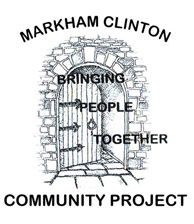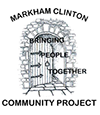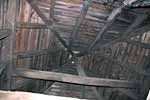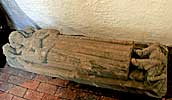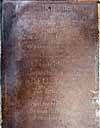Welcome to All Saints Church West Markham!!
The little village of West Markham was once the site of an ancient Saxon settlement.
You entered by the SOUTH DOOR made of three oak planks dating from the 14th century. The door is contemporary with the doorway itself.
The porch was added in the 16th century.
Facing the door is the NORMAN TUB FONT is dated no later than 1090. The crude carvings are believed
to depict the apostles; one shows Mary with the baby Jesus.
As you move to your right towards the altar, you see an exposed section of wall showing the SAXON
HERRINGBONE STONEWORK.
Above, the window has carvings on either side.
On the left are HOP VINES and on the right, a
SALAMANDER (a biblical symbol of life).
THE SCREEN, PILLAR ALMS BOX and ALTAR RAILS are all Jacobean.
The PULPIT is Elizabethan.
The BURIAL SLABS in the chancel floor are of previous vicars and their families, several known to be
“buried in wool”.
The LEAD PANEL mounted on the north wall of the chancel is part of the original roof damaged in a severe
storm.
It bears the name of the church wardens at the time.
The HIGH ALTAR is stone and bears five crudely carved crosses representing the wounds of Christ.
The STONE FRAGMENTS are Romanesque and are thought to have been supports for an earlier altar.
The STONE FIGURE is that of a clerk in holy orders.
The BISHOP’S CHAIR and PRIE DUEU was originally in Southwell Minster having been made by Advent
Hunstone of Tideswell.
As you return to the back of the church you will see the OLD OAK TABLE which is Jacobean and was
used as a Communion Table at the Mausoleum.
The OLD OAK BENCHES are Elizabethan. It is recorded that in 1584 nine men were prosecuted for
playing football in the churchyard on a Sunday. A fight ensued and one man died. The guilty were
sentenced to corporal punishment. One landowner was allowed to commute his penalty – to provide seats
in which the parishioners might take the sacrament.
The SCREEN facing you to the west is a very recent addition from 1922. The internal west wall is original
but the outer wall is some five feet away. The intervening space is filled with rubble. The extension was
added to support the bell tower which contains a single bell C15.
The ANCIENT LADDER is believed to be late Saxon.
The SUNDIAL at the south-east corner was probably used to show the time of the next service.
There are THREE OLD CARVED BOSSES set in the Nave roof.
NORMAN
The South Doorway and the Priests’ Doorway
The Piscina (south wall by the altar) revealed during 1930s renovations
The Font is dated no later than the 1090s.
Note the crude figures on the font, a priest with a chalice, two
holding books, with cloaks and some with belted gowns
15th CENTURY
Bell Turret, external wall, intervening space filled with stone rubble. The bell dates from 1450 and the
Ancient Ladder is from a similar date
ELIZABETHAN
THE Pulpit, Jacobean Table now at the west end of the nave was formerly the altar table at the Mausoleum.
The Ancient Church Chest
The Porch with the half-timbered gable was added in the 16th century.
The Church was left empty and derelict from 1833 to 1949. Attempts at restoration were made in the late
1930s
There is a mutilated stone figure believed to represent a member of The Lascelles family who were Lords
of the Manor until the time of Henry VIII
Opposite the church in the Homestead Field of Hall Farm are some interesting earthworks which indicate a
Saxon Settlement
ALL SAINTS CHURCH, WEST MARKHAM
All Saints’ is a small church, grade I listed, which stands in the hamlet of West Markham. The parish is made up of the hamlets of West Markham, Milton, and Bevercotes. West Markham is also known as Markham Clinton.
West Markham nestles in a hollow but a stone’s throw from the Old Great North Road. It does not really command the attention of a passer-by yet this was an early Saxon settlement.
The church porch looks out onto the home meadow of Hall farm. This is scheduled as an ancient monument considered to be the earthworks of a medieval settlement and, as such, a particularly important site.
The church comprises an aisleless nave, with south porch, a half-timbered western bell turret, and a chancel. There is evidence of Norman and Transitional fabric, and later medieval work. The building was restored between 1930-45 after suffering years of neglect.
Particular thanks to Jean Gilbert for research on this entry and to Geoff Buxton and Dr Chris Brooke for the photographs
History
Herringbone work
in south wall
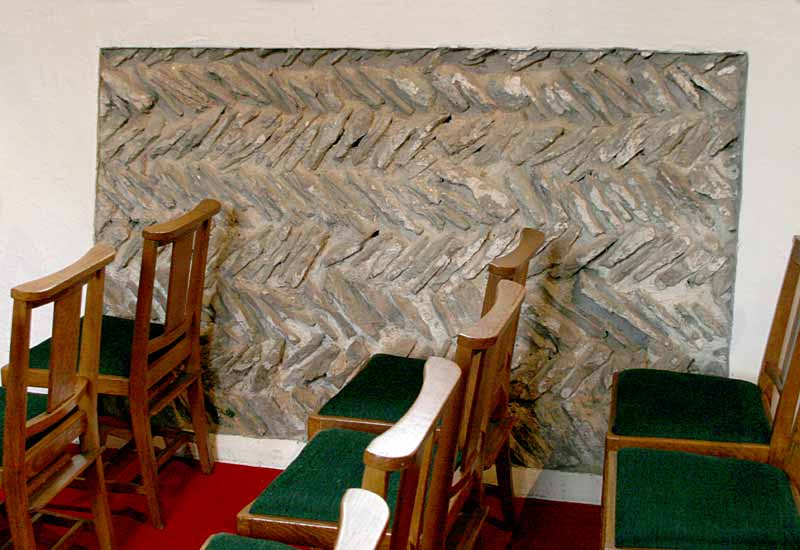
Although no accurate date can be given for the founding of All Saints’ church, experts consider there is a sufficient core in the structure to authenticate its probable Saxon origins. Indeed, in recent years, shards of Roman pottery were found in the floor by the altar.
The earliest records of the village itself are to be found in Domesday Book of 1086, though there is no record of a church or priest. William the Conqueror allocated lands to Roger de Busli who established his castle at Tickhill (South Yorkshire). Included in his great estates was West Markham.
Over the centuries the village has also been known as Parva Markham and Little Markham.
Thoroton records an agreement between the church of West Markham and the chapel of Tuxford (1189), relating to tithes for a portion of land. The men were to take offerings of calves, foals, lambs, goats, and pigs (with eggs also at Easter) to West Markham, three times each year on All Saints Day, the Purification of St Mary, and at Easter. They were to be confessed there in Lent, receive communion there at Easter, and the bodies of their husbands and wives were to be buried there. At this time West Markham was the ‘Mother Church’, Tuxford having only a Chapel of Ease.
Eleanor of Aquitaine, Queen of Henry II, founded a royal free chapel in the castle at Tickhill, endowing it with tithes of several Nottinghamshire churches, including West Markham (together with Harworth, Walesby, North Wheatley and East Markham).
King John, when Earl of Mortain (1191-3) gave West Markham church, together with the chapels of Bevercotes, Kirton, Walesby, Haughton, Drayton, Gamston and Everton to the Archbishop and Chapter of Rouen, to whom they were appropriated and vicarages ordained in 1257. Bevercotes was a chapel of West Markham but others had no connection. The chapel at Bevercotes fell down in 1650.
A translated copy of the agreement between the Chapter of Rouen and the Archbishop and Chapter of York is held by Nottinghamshire Archives.
In the 1291 Taxatio of Pope Nicholas IV, West Markham church was valued at £8, with the vicarage valued at £8, and £6 13s 4d noted as a pension to the college and chapter of York Minster. Fifty years later, the Nonae Rolls record the total value of the church at only 22 marks (£13 6s 8d).
In spite of the appropriation to Rouen, Robert Clarel, as a Warden of the Tickhill chapel, claimed the right of presentation by 1286. His successor Boniface de Saluzzo, claimed those churches formed a ‘Peculiar’ – thus exempt from the jurisdiction of the Archbishop of York. Although his claim failed, he retained advowsons until his death. Successive wardens were patrons until 1474, when Edward IV granted the advowsons to Lenton Priory. In 1503 Henry VII gave the patronage to Westminster Abbey. On 10th July 1552 the rectory of the free chapel of Tickhill, with all its advowsons, was given to the Earl of Shrewsbury, subsequently passing to his successors, the Dukes of Newcastle.
In 1589 the churchwardens presented that the chancel was in decay in default of the Earl of Shrewesbury. In 1596 the churchwardens and one swornman presented that their vicar was a preacher and favourer of God’s word; they have had two sermons by Mr Feilde and their vicar Mr Chapman; the vicar was not resident on his vicarage, nor did he give any relief to the poor; the chancel and the vicarage house were not in good repair. Two years later they were reporting that the glass windows in the chancel were decayed and the windows in general were out of repair, also that the lead that covered the bells was rolled up with the wind and the churchyard fence was broken; one Richard Knighte was presented for ‘playing on his instrument in time of divine service’.
In 1603 the chancel was apparently still ‘in decay’, the responsibility of the Earl of Shrewsbury, and by 1612 the churchwardens presented one Mr Tharland ‘for default of our chancel mending’. Clearly little happened over the next few years as by 1620 the chancel was reported as being ‘very ruinous’. Two years later, the minister, Robert Bruen, admonished his parishioners saying that notice had been given to some of his parishioners of the churchyard fence lying down, but no order has been taken to make it up; he asked Mr Malin to ‘awaken your dullness’ and cite John Fox and Jeffery Leighes for neglect. Problems with the state of the chancel continue to be reported throughout the 1620s and 1630s with the slates being defective in 1627 and the windows ‘out of repair’ in 1634. Four years later, the parish was taking matters into hand and it was reported that William Oldham and William Thorpe, farmers of the parsonage, were to repair two parts of the chancel, and the next year the churchyard was apparently ‘all sufficiently repaired’, 21s 8d having been laid out in repair of the church.
Following the Civil War, by 1665 all seems to be reasonably well with the fabric of the building as it was stated that ‘our parish church is in very good repair, only we want some few utensils viz. a church Bible, and our churchyard is not fenced as well as we intend it, for which we desire time until the next visitation’. All is quiet until 1679 when the churchwardens reported that ‘a little part of the church wall did lately fall down, but we have begun to provide materials and workmen to repair it as speedily as may be’.
In April 1684 the churchwardens’ presentment is unusually detailed:
we have no hearse cloth, but the rest of the church utensils are generally very good and in safe hands, but not usually delivered from the old churchwarden to the new by bill indented; we have no poor man’s box, nor locks upon our chest; our church is decently kept and in tolerable repair, except some drops in the leads and a few slates wanting on the porch, both which will speedily be repaired; our chancel was never paved since the steps were taken down in the “late times of Rebellion”; we have no terrier of our glebe, nor book of Homilies; our churchyard fences, formerly presented, are well amended; our minister has not read the statute against profane swearing and cursing, nor knows anything of it; our chancel floor is not paved, and it ought to be done; two parts by my Lord of Clare and one part by our minister.
The following year it was reported that the church wall had fallen down on the north side.
In 1718 the churchwardens stated that ‘church wants beautifying within; a hearse cloth, a hearse cloth and a poor man’s box with three locks and keys wanted’. The following year a certificate was issued by the curate, churchwardens, and parishioners saying that that walls had been repaired with lime and hair inside and had been whitewashed inside; the roof, windows, pavement and seats had been repaired; the table of prohibited degrees of marriage, the Creed, the Lord’s Prayer, the Ten Commandments, the King’s Arms, and the Book of Homilies had been supplied; a poor man’s box, basin for alms, hearse cloth and cushion had also all been supplied.
In 1743 there were forty families in the parish, none of them dissenters. There was a free school for all the parish children but no almshouses. The vicar read the services each Sunday and administered the sacrament three times a year to between 30 and 40 of the 70 communicants.
On 10th May 1824 a Faculty was granted by the Archbishop of York to the vicar and churchwardens of the parish of West Markham, to take down the parish church, known as All Saints, and to rebuild the same on a more convenient and elevated situation.
‘The Mausoleum’
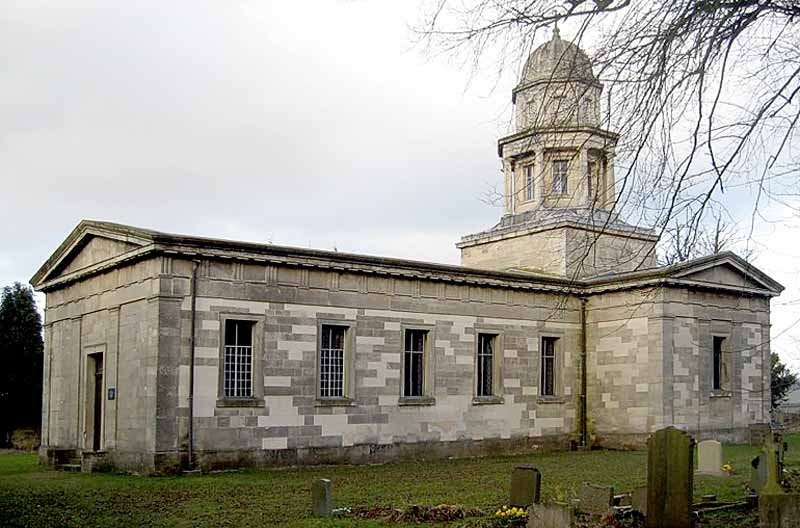
The Duke of Newcastle, at his own cost, built the new church, known as The Mausoleum some 800 yards away from the ‘Old Church’. The Mausoleum was built on the instructions of the fourth Duke, as a resting place for his Duchess, Georgiana Elizabeth, who died, aged 34, giving birth to twins in 1822. The Mausoleum was consecrated by the Archbishop of York in 1833, and it became the parish church.
All Saints was allowed to fall into disrepair but, fortunately, not demolished.
The new church had 210 sittings, and on census Sunday in 1851 65 attendees in the morning and twenty scholars.
In 1912 there had been one baptism and six confirmations over the previous twelve months. There were 53 children in the school and 26 in the Sunday School.
Records show that two baptisms and a wedding took place in the ‘Old Church’ and a number of burials took place in its churchyard. In 1945, the Duke of Newcastle sold his estates, and took no further interest in the family mausoleum, though some ten members of his family lie buried there. It was impossible for the local community to maintain two churches, and the old church was subject to a major restoration.
In 1949, the Vicar, his churchwardens and a number of inhabitants, petitioned the Vicar General and the Bishop of Southwell that the ancient church again become the parish church in lieu of the Mausoleum. In spite of opposition by the duke’s representatives and ‘divers inhabitants’ on 28 October 1949 the ancient church re-emerged as the parish church. Over the years since then it has been restored to its present state.
The mausoleum ultimately passed into the care of the Redundant Churches Trust Fund (now the Churches Conservation Trust).
However, the churchyard at the mausoleum remains the burial ground for parishioners and its care and maintenance remains the responsibility of All Saints, West Markham.
Archaeology
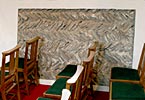 Herringbone work Herringbone workin south wall |
The church is a simple, rectangular structure composing nave and chancel. The walls are built mainly of rough stone and some brick, with some herringbone work in the stone, some of which is clearly visible above the south door, and a panel is left exposed on the internal south wall. Externally the walls are covered with render.
In the 19th century a heavy storm caused parts of the walls to collapse at the north-east corner of the church, and the roof was also damaged. The church was re-roofed with pantiles. A section of the original lead is mounted on the north wall of the chancel. It contains the names of the churchwardens at that time. The wall was rebuilt in brick.
At the west end of the church the floor is the original earth floor. This is now visible by means of a hatch in the raised wooden platforms.
Nave
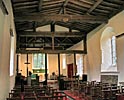 Nave looking east Nave looking east |
Single-celled, aisleless space, local stone construction with evidence of counterpitched rubble work, probably 11th or early 12th century. South doorway is Transitional c1190. South door is early medieval, possibly C12th century. There are windows of 13th to 15th century date. Font probably last quarter 11th century. Roof probably 15th century in origin with heavy ties and short king posts, but with much 20th century restoration.
Porch
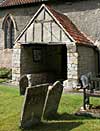 Porch Porch |
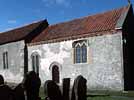 The chancel from The chancel fromthe south-east |
Located at the south-west side of the nave. Local stone construction with half-timbered gable. Probably all 17th century.
Chancel
Single-celled space, local stone and brick construction. Much mid-20th century rebuilding on north and east sides. South doorway late 12th century, windows of 12th to 15th century date. Screen remnants probably 15th century. 12th and 14th century piscinae.
Western bell turret
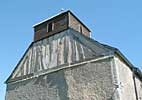 |
A half-timbered structure running the width of the nave at the west end designed to house the bells, with weatherboarded turret and pyramidal cap above. Unusual timber construction for Nottinghamshire. Date unclear, but possibly medieval in part with later alterations.
Technical Summary
Timber and Roofs
Bell Frame
The frame is an Elphick E / Pickford 6.M. variant (the top cill is mortised into the end posts, not the end posts mortised into the top cill). There are pits for two bells but only is used and there is no indication in cut-out markings that the second has ever been used. Scheduled for preservation grade 1.
Walls
| Nave | Chancel | Tower | |
| Plaster covering & date | Plastered and colourwashed, much probably 1930-45 | Plastered and colourwashed, much probably 1930-45 | None |
| Potential for wall paintings | Wall paintings possible below later restoration work | Wall paintings possible below later restoration work | nil |
Excavations and potential for survival of below-ground archaeology
Excavation was undertaken prior to 1982 alongside the south wall to create a drain; no archaeological monitoring took place and much stratigraphy has evidently been destroyed.
The majority of the fabric dates from the mid-C12th to the C15th with some work in the C17th. A major mid-C20th restoration was undertaken between 1930-45, though this was largely concerned with the stabilization and rebuilding of the chancel and the roofs. It is expected that below-ground stratigraphy in the nave will remain largely undisturbed apart from later burials and the insertion of floors and seating. It is to be noted that an earthern floor remains at the west end of the nave and this area may remain largely undisturbed from the medieval period. The chancel has been considerably rebuilt in 1930-45 especially on the north and east sides and although evidence of earlier phases will probably survive below ground, much medieval stratigraphy is likely to have been heavily disturbed or destroyed.
The standing fabric of the nave and the south wall of the chancel retain considerable medieval fabric; in the nave this may possibly predate the C12th, evidenced by counterpitched rubble work which may be of the C11th. The side walls appear to contain mainly C12th to mid-C15th fabric. The north and east walls of the chancel date mainly from a rebuilding of 1930-45 in red brick.
The churchyard is approximately circular in form which may be indicative of an early date. The church itself is located towards the south end of the churchyard. Burials are evident to the south of the church though it appears that grave-markers have probably been cleared from the north side. The earliest marked burials appear to be of the early C18th.
The overall potential for the survival of below-ground archaeology in the churchyard, is considered to be MODERATE–HIGH, comprising mainly burials of all periods, along with access paths. Below the present interior floors of the nave and below the west bell turret it is considered to be HIGH–VERY HIGH; below the partially rebuilt chancel MODERATE. The standing fabric of the church remains largely intact apart from the north and east walls of the chancel and the overall potential for surviving medieval archaeology in the standing fabric of the church is considered to be VERY HIGH.
Exterior:Burial numbers expected to be average, with later burials to the north. The churchyard boundaries may prove interesting due to its circular shape.
Interior:Stratigraphy under the nave is likely to be scanty C17/18/19th layers with earlier, medieval deposits beneath. The chancel is likely to have heavier disturbance due to the mid-C20th restoration but with the probability of surviving earlier deposits. In the body of the church the stratigraphy is likely to be punctuated by medieval and post-medieval burials.
Glass
All windows have plain glass. They were reglazed in 1939.
Organ
The organ was introduced into the church in the 1970s having been given by the family of a bride who was to be married in the church. It is an American Conn organ, and was converted to a digital system in 2000.
Bells
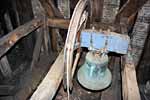 Bell and bell frame Bell and bell frame |
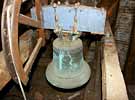 Bell Bell |
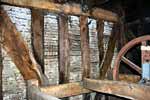 Rear of the gable wall Rear of the gable wall |
The external wall of the bell turret is some five feet from the internal wall. The intervening space is filled with rubble. There is one bell although there is housing for two bells in a wooden bellframe – Elphick E / Pickford 6.M variant (the top cill is mortised into the end posts, not the end posts mortised into the top cill). According to records of 1552 there were at that time two bells. The existing, single bell, though blank, can be attributed by stylistic considerations to about 1500; it was repaired and re-hung in 1992 when the bellhanger Fred Pembeton replicated what was there before, swing chiming with half a wheel, the frame itself needed no repair except for the bearing mountings.
Clock
There is no clock.
 Mass dial Mass dial |
The church has a weather worn mass dial on the outer wall at the south-east end of the church.
Churchyard
The churchyard is approximately circular in shape, though truncated on the east side by Parson Lane. The church is set slightly south of centre within this space, and there are extensive grave-markers to the south. The area to the north has probably been cleared of markers. The churchyard is bounded by mature trees and hedges on all sides, by roads to the south, east, and west, and by agricultural land to the north.
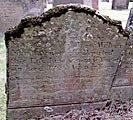 Grave of William Minnit Grave of William Minnit(died 1726) |
 Grave of John Minnit Grave of John Minnit(died 1758) |
Four of the gravestones, lying to the south of the church, are separately listed grade II. They are to William, Mary and William Minnit and John Minute who died 1726, 1725, 1751, and 1758 respectively. They have salutary epitaphs. One upon the grave of William Minnit (1741) reads:
| Ye men that Harpeth after wealth, As for my parts done myself For to lay riches up in store, and labour’d hard for to Gain more When cruel death seized me so fast I thought I’d gain’d enough at last As for my wealth I say therefore, My will was to be kind to the Poor. A whilst your Poseing thus of me; think of the glass that runs for thee. |
This is surmounted by a sketch of an hourglass.
The second epitaph is of a member of the same family, 1758.
| With toylsom Day and Ancious Night, To gain great wealth was my delight. But Death o’er took me and ye summon: gave And sent my body for to rest in Grave. Defer your judgement on what I have done For judgement Day is Comeing on. To 14 Benefactors I have left my store and £20 unto West Markham Poor. |
List of Incumbents
List of Vicars
| Date | Name |
| 1179 | Henry |
| 1265 | William |
| 1292 | William de Bevercote |
| At 1st August 1300 William de Bevercote appears in the list of Rectors at Tuxford, being described as King’s Clerk, Chancellor of Scotland, and as Parson of West Markham. | |
| 1293 | William de Gamelston |
| 1294 | John de Stocwell |
| 1313 | Richard de Hoton |
| 1316 | Richard de Roderham |
| 1327 | Thomas Coks de Ravenser |
| 1349 | John de Clone |
| 1351 | William de Haveringham |
| 1352 | Thomas de Guthmundham |
| Thomas Curteys | |
| 1366 | William Launde |
| John de Hendeley | |
| 1401 | John de Marton |
| 1411 | Robert Fall |
| 1429 | William Rossell |
| John Malyn | |
| 1447 | John Tapet |
| 1468 | John Lachfeld |
| 1471 | Thomas Vicars |
| Charles Langwith | |
| 1538 | William Walton |
| 1572 | Henry Frith |
| 1595 | Francis Chapman |
| 1616 | Charles Lawson |
| 1619 | Robert Bruen |
| 1636 | Thomas Holmstead |
| 1650 | Robert Millner |
| 1663 | Thomas Weston |
| John Birch (September) | |
| John Burton (December) | |
| 1691 | William Carter |
| 1739 | Thomas Peete |
| 1775 | Francis Holliday |
| 1787 | Benjamin Cromwell Brown |
| 1803 | John Crawford |
| 1806 | George Booth |
| 1828 | Edward Henry Dawkins |
| 1858 | Alexander Douglas |
| 1863 | Henry Revell Reynolds |
| 1872 | Seymour Bentley |
| 1902 | Henry Percy Atkinson |
| 1912 | George Pelham Crookenden |
| 1945 | John Richard North Hooker |
| 1964 | Thomas William Swift |
| 1980 | Roy Palin |
| 1990 | Joseph E. Martin |
| 2001 | Elizabeth A. Thomas |
| 2008 | Colin Wall |
